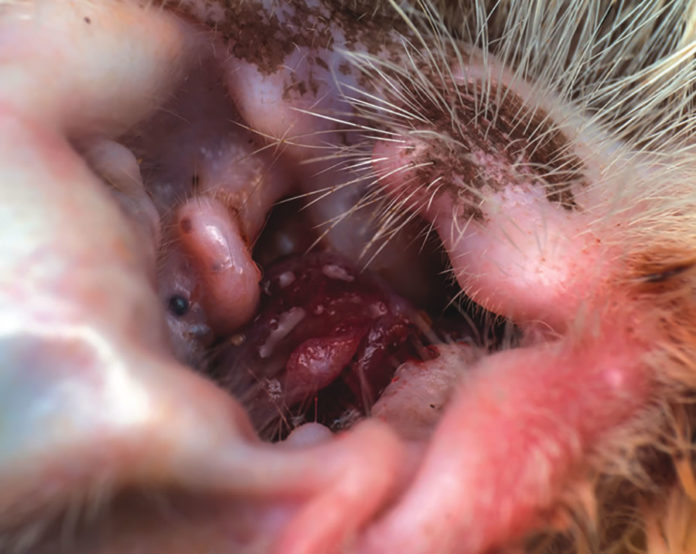Q. I have a 16-year-old cat, and he has developed a tumor in his ear canal. It has been active and growing for six months. I have discussed options with my veterinarian, and the surgery is radical. I don’t think it is the correct option for my cat. I clean the ear every day because it bleeds and there is an odor associated with it. I use MotaZol and ZYMOX on alternate days. Can you provide any advice about how it might be best to proceed?
A. Thanks for getting in touch, and I am sorry to hear of your kitty’s problem. I completely understand your reluctance to subject your cat to such a surgery, but perhaps a brief review of feline aural (i.e., related to the ear) tumors would help you make this important decision.
Aural tumors in the ears of cats most commonly arise from ceruminous glands (a specialized type of cell lining the ear canal that produces sweat, among other secretions). Unfortunately, ceruminous gland tumors are more commonly malignant (i.e., adenocarcinomas, accounting for approximately two-thirds of feline aural ceruminous gland tumors) than benign (i.e. adenomas, accounting for one-third of feline aural ceruminous gland tumors) in cats. There is some evidence that these types of tumors may be more common in cats that have experienced chronic ear infections. Other malignant (i.e., squamous cell carcinomas) and benign (i.e., inflammatory polyps and basal cell tumors) masses may occur, but these are less common.
Ceruminous adenocarcinomas tend to invade other local structures, including the bones of the skull, and may metastasize to other areas, including local lymph nodes, salivary glands, and the lungs. Adenomas and polyps do not generally invade other structures, but may grow to the extent that they can occlude the ear canal and put pressure on adjoining tissues.
Regardless of whether they are malignant or benign, aural tumors can become ulcerated and may bleed and become infected, resulting in pain, itchiness, and, in some cases, balance problems if they invade the inner ear or an associated bacterial infection penetrates to this region.
The definitive diagnosis of aural tumors requires a biopsy, obtained either during otoscopic examination (this requires sedation or anesthesia) or by surgical removal of the tumor, which requires anesthesia. Advanced imaging of the head, including computerized axial tomography (CAT) scan and/or magnetic resonance imaging (MRI) may be recommended to more accurately characterize the extent of local invasion of the tumor in question.
The therapy of choice for aural tumors in cats is surgical removal, as this can be curative in the case of benign tumors and can provide a survival benefit with malignant tumors. For malignant tumors, radical surgery, including ablation (surgical closing) of the ear canal, combined with radiation therapy and/or chemotherapy may be recommended, depending upon the type of tumor and how invasive it is.
I hope that this is helpful, and I know that this is an important and difficult decision. I recommend that you continue to work closely with your veterinarian, and perhaps a veterinary oncologist, to help you make the right choice for your situation. Please send us an update when you can, and we wish the best of luck to you and your baby.




